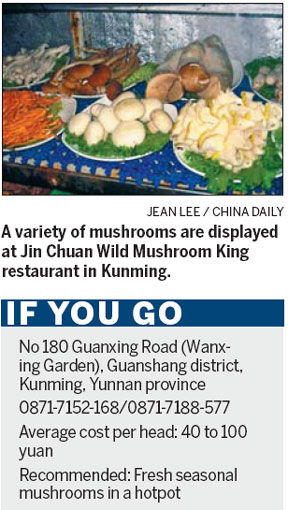Seasonal Yunnan mushroom hotpot
Updated: 2012-09-15 07:49
By Jean Lee (China Daily)
|
|||||||||||
Every year, from June to September, it is mushroom season in Yunnan province. This is when the fresh wild fungi finds an eager following all over the country but especially in the hotpot restaurants in the provincial capital Kunming. This is when timely visitors to Kunming will be treated to an all-natural feast.
The mushroom hotpot street in Kunming is along Guanxing Road, at Guanshang, near the old airport and Expo Center. The whole stretch is dotted with mushroom hotpot restaurants that serve only this specialty and are only open during this time of the year.
Some of the restaurants serve regular dishes at other times, but they, too, will be pushing the fresh mushrooms - all types, from the common porcini to the exclusive matsutake.
The seasonal popularity of these eateries can be seen by the number of cars double-parked on both sides of this four-lane road, which is also serviced by bus route No 122.
I was told in the old days, the varieties of mushrooms were always harvested wild from the mountains surrounding major towns in Yunnan. But because of the popularity of these fresh mushrooms all over China, they are now mostly cultivated to satisfy ever-growing consumer demands.
For someone not from Yunnan, the variety of mushrooms can be mind-boggling.

Their names are all strangely exotic and mostly derived from the physical characteristics of the mushrooms. Old man's head mushrooms are reminiscent of an elderly gentlemen's cropped scalp of white hair. Pig's stomach and chicken drumstick are named for the tactile similarities to their namesakes, while the seafood mushroom supposedly tastes like, well, seafood.
There are other better-known and recognized varieties, like the lacy-white bamboo boletus and the highly prized and exorbitantly priced matsutake or pine mushrooms.
Matsutake were common both in price and quantity until Japanese tourists recognized them as a prized autumn delicacy. Pretty soon, prices went north.
Once, on a road trip from Yongsheng to Lijiang, we came across villagers by the roadside selling freshly picked matsutake wrapped in leaves. The ones that were not so well-formed were going for about 70 yuan ($11) per kilogram, but the better-looking mushrooms had an asking price of 120 yuan.
Our mushroom hotpot feast at Jin Chuan Wild Mushroom King in Kunming started with a huge pot of goose stock, into which was added sliced fresh arrowhead bulbs, day lily buds and sweet potato vermicelli. There were also leeks, lotus roots and Chinese lettuce, and a set assortment of mushrooms.
The hotpot restaurants take all precautions, and waitresses will cook the various mushrooms in careful order, and tell you when they are cooked and ready to eat. Trust them, because some of the wild mushrooms are mildly toxic until they are thoroughly cooked.
For a more substantial meal, we had steamed white rice, spring onion pancakes and pumpkin pancake with a red bean paste filling. It was all very affordable, but would have cost considerably more had we ordered additional plates of matsutake.
sundayed@chinadaily.com.cn
(China Daily 09/15/2012 page12)
Today's Top News
Rescuers race against time for quake victims
Telecom workers restore links
Coal mine blast kills 18 in Jilin
Intl scholarship puts China on the map
More bird flu patients discharged
Gold loses sheen, but still a safe bet
US 'turns blind eye to human rights'
Telecom workers restore links
Hot Topics
Lunar probe , China growth forecasts, Emission rules get tougher, China seen through 'colored lens', International board,
Editor's Picks

|

|

|

|

|

|





